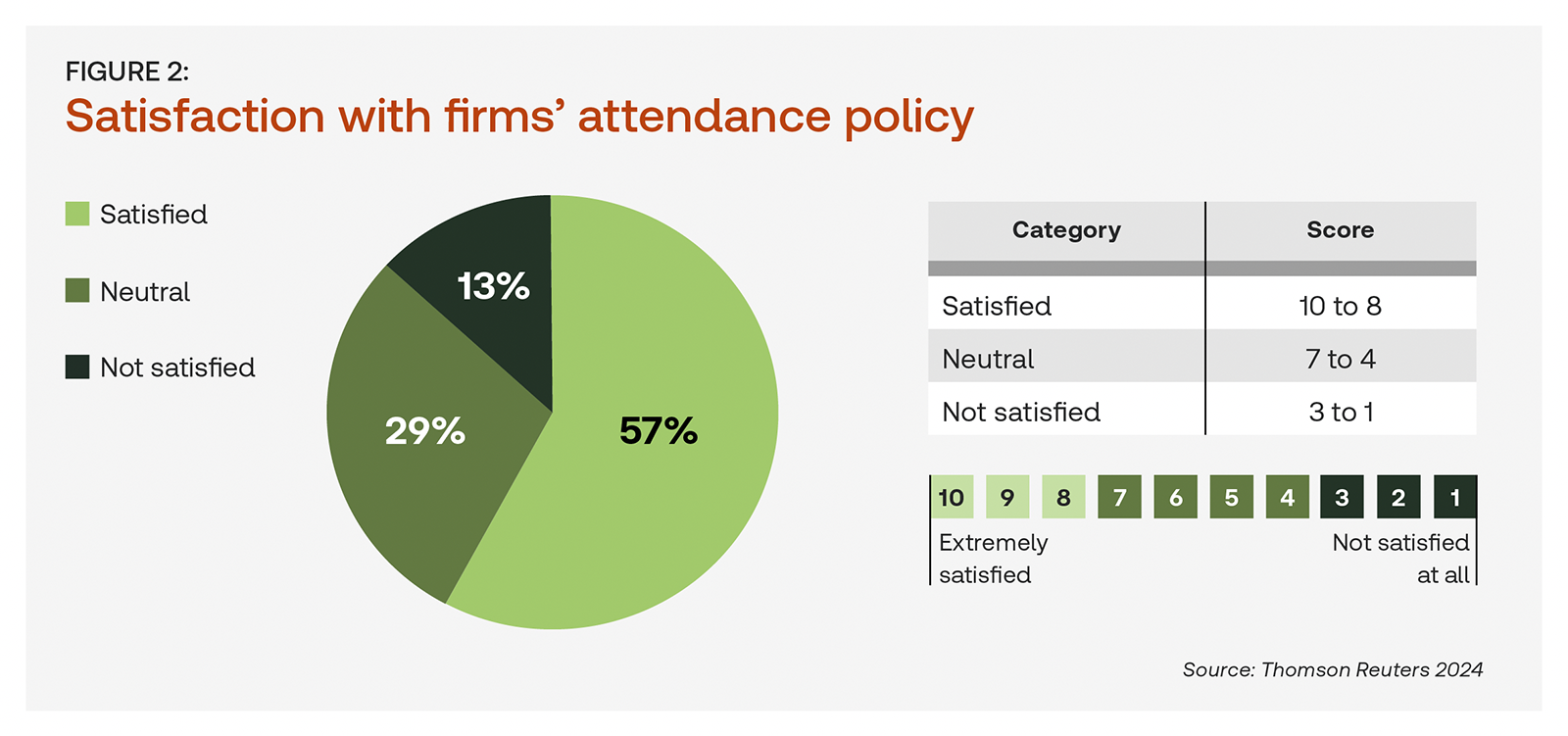Law firms are outpacing other businesses in employee satisfaction with return-to-office policies that strike a balance between employee and firm needs
Return-to-office mandates and hybrid work schedules are front-of-mind issues for many professionals. Employers and their employees alike have differing priorities and goals, making for quite a bit of debate about what is the best way to approach office attendance policies.
Two recent studies offered interesting — and seemingly contrasting — views. While Thomson Reuters Institute’s recent 2024 Law Firm Office Attendance Policies Report found that many legal professionals are enthusiastically embracing the return to office, another study by the University of Pittsburgh — a meta-analysis of other organizations’ surveys and reports — reported negative effects to the point where it recommended that employers may wish to re-evaluate their return-to-office policies.
What accounts for this seeming disparity? Some of the variance between the two reports’ findings may be due to differences between the work environments of law firms and S&P 500 companies. With most law firms being partnerships, partners are not only owners and managers but also function as employees at the same time, perhaps making them more attuned to frontline working conditions than are managers in other industries. Also, with the increased attention being paid in recent years to lawyer well-being, including mental health and preventing burnout, law firm leaders may be making a concerted effort to create office attendance policies that align with balancing employees’ desires.
At the same time, both reports point to some key elements that may influence whether new office attendance policies succeed for any organization. The differences may lie in how and why return-to-office and attendance policies are implemented.
Where differences may lie
The Thomson Reuters Institute report surveyed legal professionals in law firms and found “startling enthusiasm” for their respective firms’ office attendance policies. An overwhelming 86% were either satisfied or at least neutral, leaving barely one-in-ten legal professionals who said they were dissatisfied with their working arrangements. Much of this is due to the surprising amount of flexibility in office attendance that many law firms have offered their lawyers. On the other hand, the study by the University of Pittsburgh’s Katz Graduate School of Business examined S&P 500 companies and found a significant decline in employee satisfaction in companies that instituted return-to-office mandates.
 Motives, intentions & goals
Motives, intentions & goals
A common thread between both reports’ findings is that an organization’s intentions, motivations and goals in pursuing return-to-office policies may be an important factor.
The University of Pittsburgh report contends that many managers are using return-to-office mandates to regain control over employees, and they blame employees as a scapegoat for bad business or stock performance. While the Thomson Reuters Institute report does not go that far, it does say that firms were hoping to see higher productivity and increased collaboration. Both reports conclude that anticipated results — such as improved performance, productivity, and collaboration — generally have not materialized as a result of returning to an office building.
However, there is obviously a major difference between hoping to see improved performance and blaming returning employees for poor business performance. While law firms may not have seen the hoped-for gains, their positive intentions for greater collaboration, as compared with using return-to-office mandates as a blame-shifting excuse, may have contributed to the high overall satisfaction level among legal professionals.
Importance of flexibility vs. One-size-fits-all
The flexibility or rigidity of return-to-office policies also may play a key role. The Thomson Reuters Institute report found legal professionals who were dissatisfied were most commonly in firms with less-flexible policies. Further, they were in the office more than the average respondent, which may also be a result of less flexible policies.
Overall, 64% of legal professionals said their firm’s overall policy is flexible, allowing them to largely choose which days they are in the office. This likely contributes to the high satisfaction levels as well. (One other factor is important to note: Many lawyers and paralegals rely on mentorship and collaboration for their work and for career development, both of which likely benefit from physical proximity with senior lawyers, practice group leaders, and partners.)
The University of Pittsburgh report similarly found that several studies of corporations tended to find both improved performance and increased employee satisfaction in cases in which the company offered greater flexibility in employees’ work-from-home and hybrid workplace arrangements.
In that sense, both reports are consistent in their findings, suggesting a correlation between policy flexibility and employee satisfaction. Indeed, this emphasizes the point that there is no one-size-fits-all solution for return-to-office policies, work schedules, and hybrid working arrangements. Rather, employers have a multitude of options and considerations in implementing these policies, including:
-
-
- number of in-office days required or suggested for each week
- alignment of in-office days (mandating or encouraging a common in-office day or days, such as having all team members in-office every Monday)
- organizational hierarchy, or having office attendance policies that differ among departments, teams, or practices rather than be organization-wide, depending on needs
- enforcement or incentives — what incentives can be provided to encourage employees to follow the policy? What are the consequences of an employee not adhering to the policy?
- Communication of goals, with the idea that the more that employees understand the reasoning and expectations for office attendance, the more likely that they may view the policies positively, or at least with a neutral stance
-
Given these options, it may be beneficial for leaders to have at least a general directional sense of employee sentiment. Employee surveys may not be practical in every case, however, and organization leaders may be understandably reluctant to allow employee preferences to drive office attendance policies. And even with high levels of employee satisfaction overall, the stricter the office attendance policies the more likely those policies will increase turnover. For example, in the Thomson Reuters Institute survey, although only a small percentage of legal professionals say they are dissatisfied with their firm’s attendance policy, a large proportion of them were unsure if they would be at their firm in six months.
Interestingly, the University of Pittsburgh report cited surveys in which a large number of managers admit making decisions based on intuition instead of fact. They said that with a more comprehensive understanding of workplace data, they would have pursued significantly different strategies for their return-to-office requirements.
Conclusion
In an industry notorious for long hours and high levels of stress, law firms may be using return-to-office strategies as an opportunity to structure office attendance policies in ways that maintain or even improve employee satisfaction.
Despite the seeming difference in results, the Thomson Reuters Institute and University of Pittsburgh reports actually represent two sides of the same coin. Both found flexibility and intentions play significant roles in determining employee satisfaction as more businesses adopt new return-to-office and attendance policies. Law firms may simply be more successful than other businesses in getting it right.
Still, the results for law firms so far are highly encouraging — and could in some cases be emulated in other industries — and suggest that many legal professionals are satisfied with them.
Leonard Lee, of Perfectense, contributed to this blog post.
You can download a copy of the recent Thomson Reuters Institute’s 2024 Law Firm Office Attendance Policies Report here.







